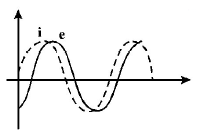Question
In the $$LC$$ circuit, the current is in the direction shown and the charges on the capacitor plates have the signs shown. At this time
In the $$LC$$ circuit, the current is in the direction shown and the charges on the capacitor plates have the signs shown. At this time

A.
$$I$$ is increasing and $$Q$$ is increasing
B.
$$I$$ is increasing and $$Q$$ is decreasing
C.
$$I$$ is decreasing and $$Q$$ is increasing
D.
$$I$$ is decreasing and $$Q$$ is decreasing
Answer :
$$I$$ is increasing and $$Q$$ is decreasing
Solution :

As it can be easily seen by the direction of $$I$$ that $$Q$$ is decreasing thus, energy of capacitor is decreasing and hence, energy of inductance is increasing or $$\left( {\frac{1}{2}L{I^2}} \right)$$ gives that $$I$$ is increasing.

As it can be easily seen by the direction of $$I$$ that $$Q$$ is decreasing thus, energy of capacitor is decreasing and hence, energy of inductance is increasing or $$\left( {\frac{1}{2}L{I^2}} \right)$$ gives that $$I$$ is increasing.
